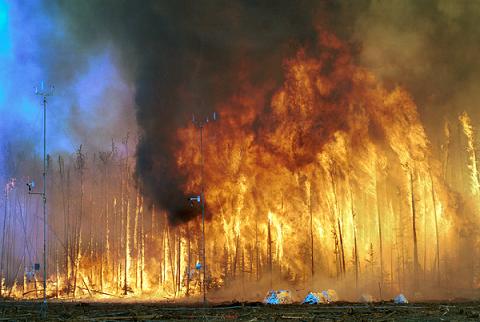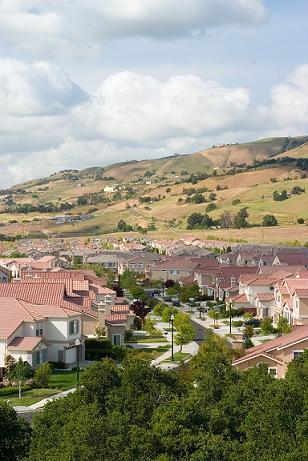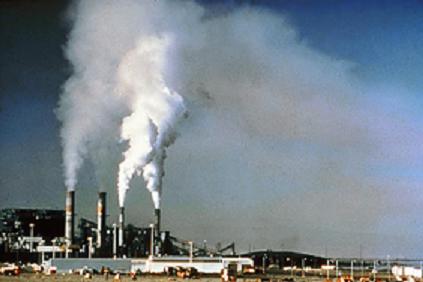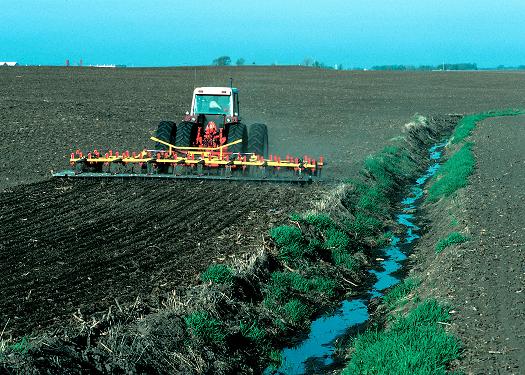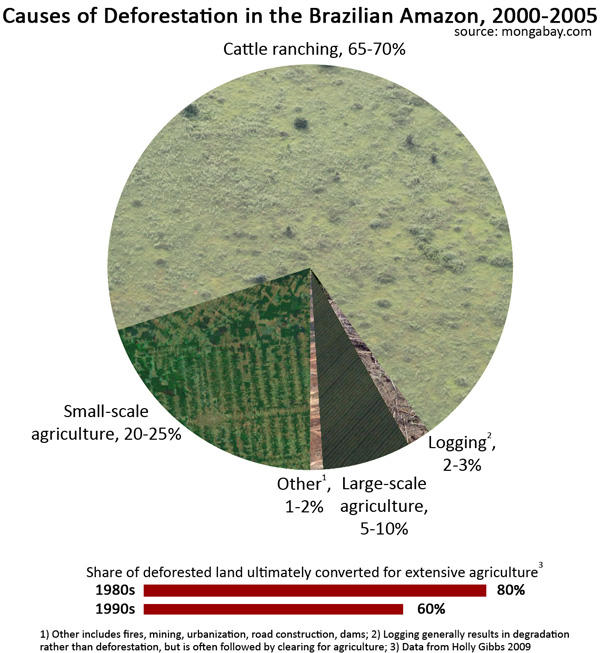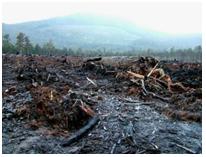Deforestation/Effects/Teacher Notes
| Module Four Objectives
|
Contents
Time Allocation
This module is estimated to take between 3 and 3.75 hours of learner time.
Introductory Activity
Ensure that the students have access to this photo. Use it as a launching point for stimulating conversation and guiding discussion. The following "I wonder" questions may serve to aid in focusing the class or group discussion:
- I wonder why this frog is so blue?
- I wonder what this frog eats?
- I wonder what sort of animal eats blue frogs?
- I wonder where in the world this frog lives?
Activity One: Causes and Effects of Deforestation
Teaching Objectives
|
The readings for this Module are the same as for Module Three (Causes of Deforestation) and can be located here: Deforestation/Effects/Readings. However, in this module, the focus of the learners will be on the effects of deforestation.
Suggested Procedure
- It is recommended that for this activity the learners are grouped according to their reading ability. Different articles, or selected parts of the articles, are assigned to the different groups. Provide enough time for the reading and discussion of the articles as well as for the recording of information.
- The educator may choose to have a large chart ready on which either the educator or the learners can record one effect per allocated section (or block) of the chart. If the educator decides to record the effects, the chart must only be made visible to the learners after the learners have drawn up their list of the effects of deforestation.
- Each learner can then be provided with the opportunity to record the supporting information in point form under the main heading in each section on the chart.
- Additionally, all overlapping information can be highlighted. This can be done by one representative from each group, or by all the individual members, depending on the class size and/or time available.
- The educator may choose to also put up a large chart listing the causes of deforestation. In this case, the learners can be provided with the opportunity to link the causes and effects, as displayed on the two charts.
The Effects of Deforestation on the Earth's 'Spheres'
The earth can be categorised into four different parts called spheres: land, water, air and living things. Scientists have given them fancy names: geosphere (land), hydroshphere (water), atmosphere (air) and biosphere (living things). These "spheres" are important because of the overlap and affect they have on each other. Trees are part of the biosphere (living things) but affect the land (geosphere), air (atmosphere), water (hydrosphere) and other living things (biosphere). Deforestation affects the four spheres differently.
1. Geosphere
The lushness of the world's tropical forests is somewhat deceptive. Although these forests have dense vegetation and many trees, the underlying soils are very poor with almost all the nutrients being held in the vegetation. As of now, about 80% of the soils in the humid tropics are acidic and infertile. The problem is that once forests have been cut down, essential nutrients are washed out of the soil altogether, leading to soil erosion. Erosion is a process where the soil is carried away by water, rain water, wind, etc.
The trees in the forest also keep the soil under them fresh and healthy. When the trees are cut down, there are no trees to keep the soil in place, and it becomes a target for erosion. It dries and cracks under the sun's heat. Once the soil temperature exceeds 25 degrees celsius, delicate nutrient ingredients like nitrogen can be lost, further reducing the fertility of the remaining soil. Furthermore, rainfall washes the remaining nutrients into the rivers. This means that replanting trees will not necessarily help to solve the problems of deforestation: by the time the new trees have matured, the soil might be completely stripped of essential nutrients. The soil will eventually be too poor to support the growth of vegetation and the land will be useless. Soil erosion eventually results in large areas of unusable land.
2. Hydrosphere
As mentioned, the hydrosphere simply refers to the water on and below the earth's surface, e.g. rivers, the sea, streams, etc. The hydrosphere is also effected by deforestation. Some of the effects are: less oxygen in waterways; water temperature changes; sediment (material that settles to the bottom of a liquid) at the mouth of rivers; and solid fragments (pieces) of inorganic or organic material that come from the weathering of rock and are carried off and deposited by wind, water, or ice. The result of this is that the aquatic (water) habitat is degraded, making it less able to sustain life, e.g. fish, plants or other organisms.
3. Atmosphere
Plants absorb carbon dioxide (CO2) and release oxygen (O2). If there are fewer trees, less carbon dioxide is absorbed and therefore less oxygen is released. This is a threat to living organisms. Decaying or burned plant life releases CO2, so with fewer living plants to absorb it, the balance of the atmosphere is effected.
4.Biosphere
Deforestation disrupts the plant and animal kingdoms. As birds, insects and other animals help with the pollination of plants and the dispersal of seeds, the loss of bird and animal species as a result of decreasing habitats, results in less pollination and there is therefore less regeneration of the forest: fewer plants are pollinated, so fewer seeds are created. As a result there are fewer seeds to disperse, and therefore fewer new plants grow.
Although all the consequences of deforestation are potentially serious, perhaps the most serious consequence is that of climate change due to the loss of trees. The earth has an atmosphere which contains a variety of gases in a delicate balance in order to sustain life. If this balance changes, then the earth is affected in different ways: one of this is the "greenhouse" effect, which is the heating of the earth due to more greenhouse gases being released into the atmosphere. This increase in the "greenhouse" gas levels in the atmosphere leads to an increase in temperature, with the possible outcomes of changing weather patterns, rising sea levels and changes in other cycles in nature that directly affect life on the earth.
One of the greenhouse gases in the earth's atmosphere is carbon dioxide. Other gases include methane, chlorofluorocarbons, nitrous oxide, and ozone. The process whereby the carbon dioxide levels increase is quite simple and these levels increase for a number of reasons. It is believed by some scientists that one of the main factors contributing to the increase of carbon levels is the decay of woody material. The only way to help moderate the levels of carbon dioxide in the atmosphere is through plant life. Living plants and trees absorb the carbon dioxide from decaying plants and trees. With a reduction in tree and plant life (due to deforestation), it is much harder to moderate these levels. Ultimately, the amount of carbon in the atmosphere will increase due to a lack of plant life which would otherwise have kept the carbon dioxide levels in check.
The effects of deforestation are far-reaching and can be irreversible if not stopped.
Activity Two: The Spheres of the Earth
Teaching Objectives
|
- The educator may desire to first look at the site "Earth's Four Spheres" for more information on the earth's spheres, before commencing with this activity.
- If possible, divide the class into four groups.
- Ensure that you have a large (A2 or A3) copy of the chart below.
- After the learners have perused the content provided in the notes, assign one of the four spheres to each group.
- Encourage all the learners in the different groups to participate in answering the three questions in the chart.
- Once each group has completed their row, add all the answers to the big chart for the entire class to see.
- Discuss the results - is there class consensus on the answers?
- Below are a number of images. Supply each group with an image.
- Ask each group to choose a representative. It is the representative's task to explain to the class what impact the event or scene depicted in the image, has on the four spheres.
| Define your Sphere. | The Impact of your Sphere on the Climate | How does Climate Change Affect your Sphere? | |
| Hydrosphere | |||
| Atmosphere | |||
| Biosphere | |||
| Geosphere |
Palm Oil
- Here is a link to an article discussing the disadvantages of palm oil Courtesy of MongaBay
- Here is a link to an article discussing the advantages of palm oil Courtesy of Malaysia Palm Oil
Activity Three: Palm Oil
Teaching Objectives
|
Suggested Procedure
- Divide the class into (preferably four) groups.
- The links to the articles are found above. Give copies of the first article to two groups and copies of the second article to the other two groups.
- Based on the information provided, the groups' answer to the question, "Should products containing palm oil be banned by the Government?" should be radically different. Record these findings on a T-Chart (see below).
- Once the findings have been reported by all the groups, gauge the general perception towards the usage of palm oil as an ingredient in products. If a strong feeling against the use of palm oil products exists, the learners can be encouraged to write a letter to the government, proposing a ban on such products, or of the use of palm oil as an ingredient.
| For Palm Oil | Against Palm Oil |
|---|---|
| Student ideas here | Student ideas here |
Question Formulation
In Module One, the following scenario and big question were provided:
- Scenario: The local forest is going to be cut down by a third to provide jobs and room for new houses to be erected.
- Question: Is deforestation good for our local and global community?
As the learners progress through the modules, it may be necessary to guide their thinking in how to write "good" questions.
- Discuss the writing of "good" questions - touch on question starters as well as keywords.
- Ask the learners to think about the type of information that will be needed to answer a specific question, such as that above. This will aid them in formulating questions correctly.
- It may also be helpful to provide the learners with a question matrix (below) to aid in the formulation of questions. In this case, ask the students to work in small groups and to write down questions to help them answer the big question.
| Keyword:deforestation | Keyword:employment | Keyword:housing | Keyword: | Keyword: | |
|---|---|---|---|---|---|
| Who | |||||
| What | |||||
| Where | |||||
| Why | |||||
| When | |||||
| How | |||||
| Which |
- Ask the learners to add a selection of their best questions to the middle column of their KWL charts. Individuals or groups can take responsibility for each question and look for the answers as the reading/research and learning unfolds. When each question has been answered, ask the learners to add that information to the right hand column.
Activity Four: Pie chart
Teaching Objectives
|
Suggested Procedure
- Print out the pie chart (below), and supply each group with a copy. Ensure that all the text pertaining to the causes of deforestation is removed from the pie chart. These causes can be written up on the white/black board in no particular order. The learners are to guess/hypothesise which portions of the pie are attributed to which causes.
- Once the learners have completed their tasks, reveal the correct pie graph. Were the students correct?
Activity Five: Word Bank
Teaching Objectives
|
Summary
| Wonderings
To summarise this module, ask the learners to reflect on (think about) the photo below, and to discuss as a class what they see in the picture. Also encourage discussion around the difference between lush forests and barren, muddy, cleared areas. 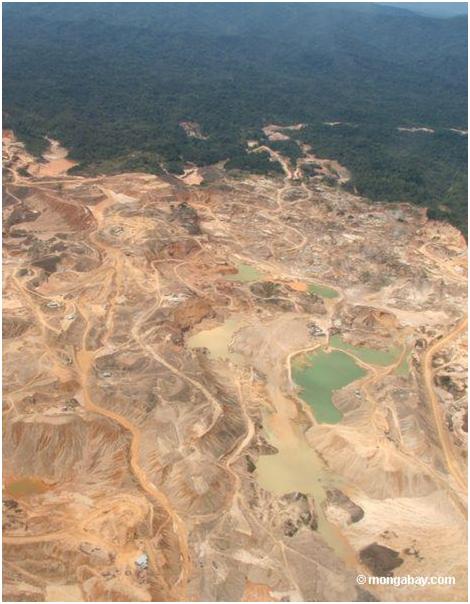 Source [1]
|
Assessment One: The Full Story
Teaching Objectives
|
Assessment Two: KWL Chart
Teaching Objectives
|
By now the educator should see substantial progress with the learners' KWL tables. To encourage further contributions, the educator could introduce the idea that a positive side to deforestation may exist. If so, provide students with copies of (or links to, if the Internet is available) the following article: *What are the benefits of deforestation?. Learners could share their thoughts on the article in groups, focusing on the potential question, "Do the benefits outweigh the negatives?" These discussions will aid the learners in answering the big question for their hypothesis.
Additional Readings
UN Report: Forests Rapidly Vanishing
Posted March 18th, 2009 by takver
World Forests are disappearing rapidly according to the 2009 State of the World's Forests report by the UN Food and Agricultural Organisation (FAO). The report notes that expansion of large-scale monocultures of oil palm, soy and other crops for agrofuel production has been a key factor in the failure to halt deforestation.
Two leading environmental organisations, Friends of the Earth
International and the Global Forest Coalition, have called on world
governments to take immediate action to halt deforestation and forest
degradation.
2009 State of the World’s Forests report | FOEI | | Global Forest Coalition
The report has also been criticised by these organisations on biofuels, illegal logging, and massive replacement of forests by large-scale tree plantations in many countries.
"Plantations are not forests," said Isaac Rojas, coordinator of the Forest and Biodiversity Program of Friends of the Earth International. "All over the world, plantations destroy the lands and livelihoods of local communities and indigenous peoples, as well as biodiversity and water resources. They also store far less carbon than natural forests."
"As they provide very little employment for rural people, tree plantations are also a major cause of rural depopulation and a further shifting agricultural frontier, thus causing the destruction of forests elsewhere," said Simone Lovera, managing coordinator of the Global Forest Coalition.
"By actively promoting monoculture tree plantations, FAO itself is partly responsible for this global trend of replacing biologically diverse forests with straight rows of usually non-native trees," she added.
The report says that the current economic crisis has affected forests in a number of ways:
"The collapse of the housing sector has reduced the demand for a wide array of wood and wood products, leading to mill closures and unemployment. New investments are slowing as a result, affecting all wood industries."
"The demand for environmental services has also changed as a result of reduced ability and willingness to pay for such services. Carbon prices have remained highly volatile. Future climate change arrangements may face challenges as countries give priority to tackling the economic crisis."
"Potential negative impacts on forest resources could include reduced investment in sustainable forest management and a rise in illegal logging as the decline in the formal economic sector opens opportunities for expansion of the informal sector. Land dependence, which had been easing, could increase, raising the risk of agricultural expansion into forests, deforestation and reversal of previous forest gains. However, there could also
be positive impacts – reduced wood demand could lessen pressure on forests, while conversion of forest for large-scale cultivation of commercial crops such as oilpalm, soybeans and rubber could slow as their prices fall."
Source
|
Photo Gallery
A number of photographs are provided in the
Photo Gallery as additional resources for the Module Summary. Alternatively these can be used at the educator's discretion at any other point in the Module.

